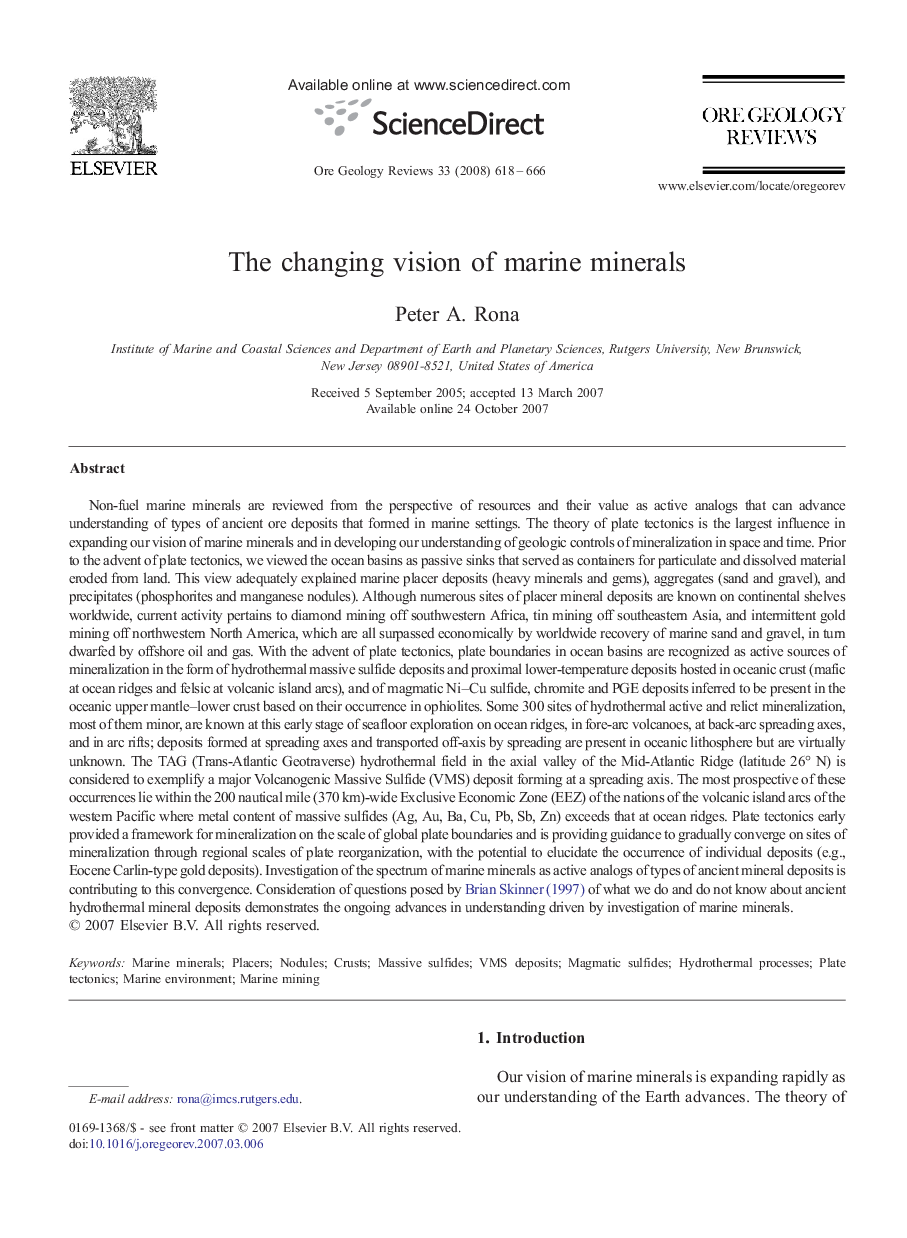| کد مقاله | کد نشریه | سال انتشار | مقاله انگلیسی | نسخه تمام متن |
|---|---|---|---|---|
| 4698038 | 1637267 | 2008 | 49 صفحه PDF | دانلود رایگان |

Non-fuel marine minerals are reviewed from the perspective of resources and their value as active analogs that can advance understanding of types of ancient ore deposits that formed in marine settings. The theory of plate tectonics is the largest influence in expanding our vision of marine minerals and in developing our understanding of geologic controls of mineralization in space and time. Prior to the advent of plate tectonics, we viewed the ocean basins as passive sinks that served as containers for particulate and dissolved material eroded from land. This view adequately explained marine placer deposits (heavy minerals and gems), aggregates (sand and gravel), and precipitates (phosphorites and manganese nodules). Although numerous sites of placer mineral deposits are known on continental shelves worldwide, current activity pertains to diamond mining off southwestern Africa, tin mining off southeastern Asia, and intermittent gold mining off northwestern North America, which are all surpassed economically by worldwide recovery of marine sand and gravel, in turn dwarfed by offshore oil and gas. With the advent of plate tectonics, plate boundaries in ocean basins are recognized as active sources of mineralization in the form of hydrothermal massive sulfide deposits and proximal lower-temperature deposits hosted in oceanic crust (mafic at ocean ridges and felsic at volcanic island arcs), and of magmatic Ni–Cu sulfide, chromite and PGE deposits inferred to be present in the oceanic upper mantle–lower crust based on their occurrence in ophiolites. Some 300 sites of hydrothermal active and relict mineralization, most of them minor, are known at this early stage of seafloor exploration on ocean ridges, in fore-arc volcanoes, at back-arc spreading axes, and in arc rifts; deposits formed at spreading axes and transported off-axis by spreading are present in oceanic lithosphere but are virtually unknown. The TAG (Trans-Atlantic Geotraverse) hydrothermal field in the axial valley of the Mid-Atlantic Ridge (latitude 26° N) is considered to exemplify a major Volcanogenic Massive Sulfide (VMS) deposit forming at a spreading axis. The most prospective of these occurrences lie within the 200 nautical mile (370 km)-wide Exclusive Economic Zone (EEZ) of the nations of the volcanic island arcs of the western Pacific where metal content of massive sulfides (Ag, Au, Ba, Cu, Pb, Sb, Zn) exceeds that at ocean ridges. Plate tectonics early provided a framework for mineralization on the scale of global plate boundaries and is providing guidance to gradually converge on sites of mineralization through regional scales of plate reorganization, with the potential to elucidate the occurrence of individual deposits (e.g., Eocene Carlin-type gold deposits). Investigation of the spectrum of marine minerals as active analogs of types of ancient mineral deposits is contributing to this convergence. Consideration of questions posed by Brian Skinner (1997) of what we do and do not know about ancient hydrothermal mineral deposits demonstrates the ongoing advances in understanding driven by investigation of marine minerals.
Journal: Ore Geology Reviews - Volume 33, Issues 3–4, June 2008, Pages 618–666